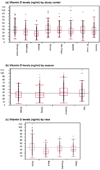Serum vitamin D levels and severe asthma exacerbations in the Childhood Asthma Management Program study
- PMID: 20538327
- PMCID: PMC2902692
- DOI: 10.1016/j.jaci.2010.03.043
Serum vitamin D levels and severe asthma exacerbations in the Childhood Asthma Management Program study
Abstract
Background: Asthma exacerbations, most often caused by respiratory tract infections, are the leading causes of asthma morbidity and comprise a significant proportion of asthma-related costs. Vitamin D status might play a role in preventing asthma exacerbations.
Objectives: We sought to assess the relationship between serum vitamin D levels and subsequent severe asthma exacerbations.
Methods: We measured 25-hydroxyvitamin D levels in sera collected from 1024 children with mild-to-moderate persistent asthma at the time of enrollment in a multicenter clinical trial of children randomized to receive budesonide, nedocromil, or placebo (as-needed beta-agonists): the Childhood Asthma Management Program. Using multivariable modeling, we examined the relationship between baseline vitamin D levels and the odds of any hospitalization or emergency department visit over the 4 years of the trial.
Results: Thirty-five percent of all subjects were vitamin D insufficient, as defined by a level of 30 ng/mL or less 25-hydroxyvitamin D. Mean vitamin D levels were lowest in African American subjects and highest in white subjects. After adjusting for age, sex, body mass index, income, and treatment group, insufficient vitamin D status was associated with a higher odds of any hospitalization or emergency department visit (odds ratio, 1.5; 95% CI, 1.1-1.9; P = .01).
Conclusion: Vitamin D insufficiency is common in this population of North American children with mild-to-moderate persistent asthma and is associated with higher odds of severe exacerbation over a 4-year period.
Copyright 2010 American Academy of Allergy, Asthma & Immunology. Published by Mosby, Inc. All rights reserved.
Figures


Comment in
-
Vitamin D insufficiency and risk of severe asthma exacerbations.Curr Allergy Asthma Rep. 2010 Nov;10(6):387-8. doi: 10.1007/s11882-010-0144-9. Curr Allergy Asthma Rep. 2010. PMID: 20725812 No abstract available.
References
-
- CDC National Center for Health Statistics. Asthma prevalence, health care use and mortality: United States. 2003–05 [cited]
-
- Masoli M, Fabian D, Holt S, Beasley R. The global burden of asthma: executive summary of the GINA Dissemination Committee report. Allergy. 2004;59:469–478. - PubMed
-
- DeFrances CJ, Cullen KA, Kozak LJ. National Hospital Discharge Survey: 2005 annual summary with detailed diagnosis and procedure data. Vital Health Stat. 2007;13:1–209. - PubMed
-
- American Lung Association. Asthma. American Lung Association Lung Disease Data. 2008 2008.
Publication types
MeSH terms
Substances
Grants and funding
- N01-HR-16046/HR/NHLBI NIH HHS/United States
- M01 RR000079/RR/NCRR NIH HHS/United States
- P01 HL083069/HL/NHLBI NIH HHS/United States
- M01 RR003186/RR/NCRR NIH HHS/United States
- N01-HR-16044/HR/NHLBI NIH HHS/United States
- N01-HR-16048/HR/NHLBI NIH HHS/United States
- N01-HR-16045/HR/NHLBI NIH HHS/United States
- N01-HR-16052/HR/NHLBI NIH HHS/United States
- M01RR02719-14/RR/NCRR NIH HHS/United States
- U01 HL 51843/HL/NHLBI NIH HHS/United States
- R21 HL089842/HL/NHLBI NIH HHS/United States
- N01-HR-16050/HR/NHLBI NIH HHS/United States
- U01 HL51845/HL/NHLBI NIH HHS/United States
- T32 HL07427/HL/NHLBI NIH HHS/United States
- N01-HR-16049/HR/NHLBI NIH HHS/United States
- U01 HL65899/HL/NHLBI NIH HHS/United States
- RR00036/RR/NCRR NIH HHS/United States
- N01-HR-16051/HR/NHLBI NIH HHS/United States
- R21HL089842/HL/NHLBI NIH HHS/United States
- U01 HL065899/HL/NHLBI NIH HHS/United States
- M01 RR00079/RR/NCRR NIH HHS/United States
- U01 HL51831/HL/NHLBI NIH HHS/United States
- U10 HL051843/HL/NHLBI NIH HHS/United States
- U01 HL075419/HL/NHLBI NIH HHS/United States
- U10 HL051831/HL/NHLBI NIH HHS/United States
- U10 HL051845/HL/NHLBI NIH HHS/United States
- U01 HL51834/HL/NHLBI NIH HHS/United States
- U10 HL051834/HL/NHLBI NIH HHS/United States
- M01 RR03186/RR/NCRR NIH HHS/United States
- R01 HL086601/HL/NHLBI NIH HHS/United States
- N01-HR-16047/HR/NHLBI NIH HHS/United States
- U01 HL51510/HL/NHLBI NIH HHS/United States
- T32 HL007427/HL/NHLBI NIH HHS/United States
- M01RR00051/RR/NCRR NIH HHS/United States
- M01RR0099718-24/RR/NCRR NIH HHS/United States
LinkOut - more resources
Full Text Sources
Other Literature Sources
Medical

